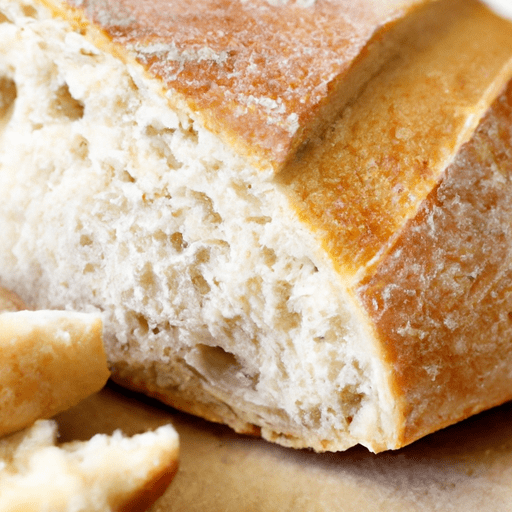The Art of Crusty Bread: A Crispy Delight
If there is one culinary pleasure that transcends cultures and brings joy to food lovers around the world, it is the heavenly delight of sinking your teeth into a crusty loaf of bread. The aroma of freshly baked bread, the satisfying crunch as you bite into it, and the myriad of flavors released as it melts in your mouth create a sensory experience like no other.
Taste and Texture
Crusty bread is a textural dream come true. Its exterior boasts a golden, caramelized crust that crackles with each bite, while the interior remains soft and chewy. The contrasting textures create a delightful balance that keeps us coming back for more. The flavor of crusty bread is often complex, ranging from slightly sour and tangy to nutty and earthy, depending on the type of flour used and the baking process.
Common Uses in Cooking
Crusty bread is an incredibly versatile staple in the culinary world. From simple sandwiches to gourmet creations, its uses are limited only by one’s imagination. Here are a few popular ways to enjoy crusty bread in your culinary adventures:
1. Bruschetta
Bruschetta, a classic Italian appetizer, showcases the brilliance of crusty bread. Slices of bread are toasted until crispy, rubbed with garlic, drizzled with olive oil, and topped with vibrant, fresh ingredients like diced tomatoes, basil, and mozzarella. Each bite is a burst of flavors and textures that tantalize the taste buds.
2. Panzanella
Panzanella, a Tuscan bread salad, is a surprisingly delightful way to use leftover crusty bread. Cubes of bread are soaked in a tangy vinaigrette, then combined with juicy tomatoes, cucumbers, onions, and fresh herbs. The bread soaks up the dressing, transforming into a soft, flavorful sponge that complements the vibrant vegetables.
3. Crostini
Crostini, the elegant Italian cousin of bruschetta, offers endless possibilities for toppings. Thinly sliced and toasted crusty bread becomes a perfect vehicle for creamy spreads, savory meats, or delightful combinations of fruits, cheeses, and herbs. Each bite-sized delight is bursting with flavor and makes for an impressive appetizer.
4. French Onion Soup
No discussion of crusty bread is complete without mentioning its essential role in French onion soup. Thick slices of bread are toasted and floated atop a rich, savory onion broth, adorned with melted Gruyère cheese. As the flavors meld together, the crusty bread soaks up the broth, becoming a warm, delicious centerpiece of this iconic dish.
Nutritional Value
Crusty bread not only satisfies our taste buds but also offers nutritional benefits. While the exact nutritional value may vary depending on the type of bread, crusty bread is generally rich in carbohydrates, providing energy to fuel our bodies. It also contains essential minerals like iron, magnesium, and selenium. Whole grain varieties of crusty bread offer additional fiber and nutrients, contributing to a healthy diet.
History and Facts
Crusty bread has a rich history that traverses centuries and continents. Some interesting facts about this beloved staple include:
- The tradition of creating crusty bread dates back to ancient civilizations, where a simple mixture of flour, water, and yeast was fermented and baked in the hot ashes of a fire.
- The art of creating the perfect crusty loaf has been perfected over time, with bakers developing techniques to achieve the ideal balance of crustiness and softness.
- There are numerous regional variations of crusty bread worldwide, each with its own unique flavors and textures. From the French baguette to the Italian ciabatta, crusty bread is a testament to the creativity and expertise of bakers across the globe.
So, whether you indulge in a slice of crusty bread as the foundation of a gourmet sandwich or savor it on its own with a smear of butter, the experience is sure to be a delight for your senses. The world of crusty bread invites you to explore its diverse uses, flavors, and history, making it a truly cherished treasure in the world of food.
Origin: Crusty bread has been enjoyed for centuries in various cultures around the world. The exact origin of crusty bread is difficult to trace, but evidence of bread-making can be found in ancient Egypt, Greece, and Rome.
Common uses: Crusty bread is versatile and can be used in various culinary applications. Common uses include:
- Sandwiches: Crusty bread is often used for creating hearty and flavorful sandwiches.
- Dipping: The crusty exterior of this bread makes it suitable for dipping into soups, stews, or sauces.
- Toast: Crusty bread can be toasted and topped with various spreads, such as butter, jam, or avocado.
- Bruschetta: Sliced and toasted crusty bread can be the base for flavorful toppings like tomatoes, garlic, and olive oil.
Nutritional Benefits: Crusty bread, like other bread varieties, contains essential nutrients. While the specific nutritional content may vary, the following are general benefits:
- Carbohydrates: Crusty bread is a good source of carbohydrates, providing energy for the body.
- Fiber: Whole grain crusty bread varieties can be high in fiber, aiding digestion and promoting satiety.
- B Vitamins: Some B vitamins, such as thiamin, niacin, and folate, can be found in crusty bread.
Unique properties and historical significance: Crusty bread has its own unique characteristics that make it distinct:
- Crispy crust: The exterior crust of this bread is known for its crunch when bitten or sliced.
- Soft and chewy interior: Crusty bread typically has a soft, moist interior texture.
- Historical significance: Bread has historically held cultural and social significance, representing sustenance and community. Crusty bread, in particular, has been a staple in European and Mediterranean cuisines for centuries.
Overall, crusty bread’s combination of texture, flavor, and versatility has made it a beloved staple in kitchens worldwide.




Use the share button below if you liked it.
It makes me smile, when I see it.